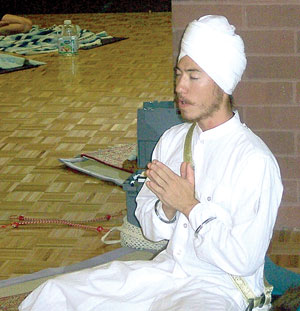Yoga instructor learns craft from recent study in India
Tera Singh Matsuda believes greatly in the importance of Kundalini Yoga,and after spending a month in Amritsar, India, helping rehabilitate drug addicts using this type of yoga, he is able to use his experiences to help teach his class at the College of Eastern Utah.

This archived article was written by: Kellie Henderson
Tera Singh Matsuda believes greatly in the importance of Kundalini Yoga,and after spending a month in Amritsar, India, helping rehabilitate drug addicts using this type of yoga, he is able to use his experiences to help teach his class at the College of Eastern Utah.
Unlike the popular power yoga that is most commonly practiced in the United States, Kundalini yoga focuses on spiritual well-being instead of being a form of physical exertion. This type of yoga uses setsof exercises and stretches (called kriyas) and the repetition of certain sounds or words (called mantras) along with meditation and relaxation to help use the body to its greatest physical, mental and spiritual potential.
Different exercises in Kundalini yoga help promote relaxation, healing, flexibility and strengthening different parts of the body.
Singh started taking yoga classes at CEU in 1997- “A friend of my dad … used to teach the class that I teach now, here at the college … she invited me to class and I came and really liked it, and I’ve been doing yoga ever since,” he said.
Tera is a Sikh, a religion established in India over 500 years ago. “It came from a time period where Hindus were the majority of India and the Caste system was used,” he says.
In the Hindu religion, a person born into a low or high caste can never leave that caste, they must stay there all their lives. The Sikh religion began with Guru Nanak who rejected the Caste system and established the idea that everyone is equal and royal. Sikhs believe in a devotion to and remembrance of God at all times and a life of service.
His name (pronounced Tay-rah, Sing) is significant in the Sikh religion. “Every Sikh, every man, takes the name Singh, and every woman takes the name Kaur. Singh means ‘Lion’ and Kaur means ‘Princess’ and this is a way for Sikhs to remind themselves that they are royal,” he says.
His first name, Tera, was given to him by his spiritual teacher, Yogi Bhajan. “It means ‘God’s lion’,” Tera explains, “so I interpret that to be about service. Nothing is mine, everything I do is for humanity, for people which, in the end, is all God.”
When asked about the most interesting things he has done, Singh recalls his participation in the Vipassana, which is a 10-day meditation course. The Vipassana takes place in India near the holy city of Rishikesh. “You’re in a community and there’s other people there, but you’re not allowed to talk through the whole week … so you can’t even make eye contact, you can’t smile at anybody … you’re not supposed to read or write anything during the whole course.”
Each day of the Vipassana consists of many hours of meditation: three hours in the morning, four hours after breakfast, three more hours after lunch. Tera explains his experience- “You start at 4 o’clock in the morning … you don’t control anything, you don’t control your breathing … you just sit there and feel your breath.”
This experience has helped him in many ways, “it’s probably one of the most powerful things I’ve done in my life. It helped me understand myself or know myself more than anything else, I would say.” The Vipassana helps to promote a healthy, wholesome way of life that began over 2500 years ago in India.
Singh is a full-time student at the college, studying to practice oriental medicine, which includes the use of herbs and acupuncture to promote healing. He is a river guide and enjoys ceramics. If he could go anywhere, he would go to Japan: “My family’s been Japanese living in America for three generations without visiting Japan.”




